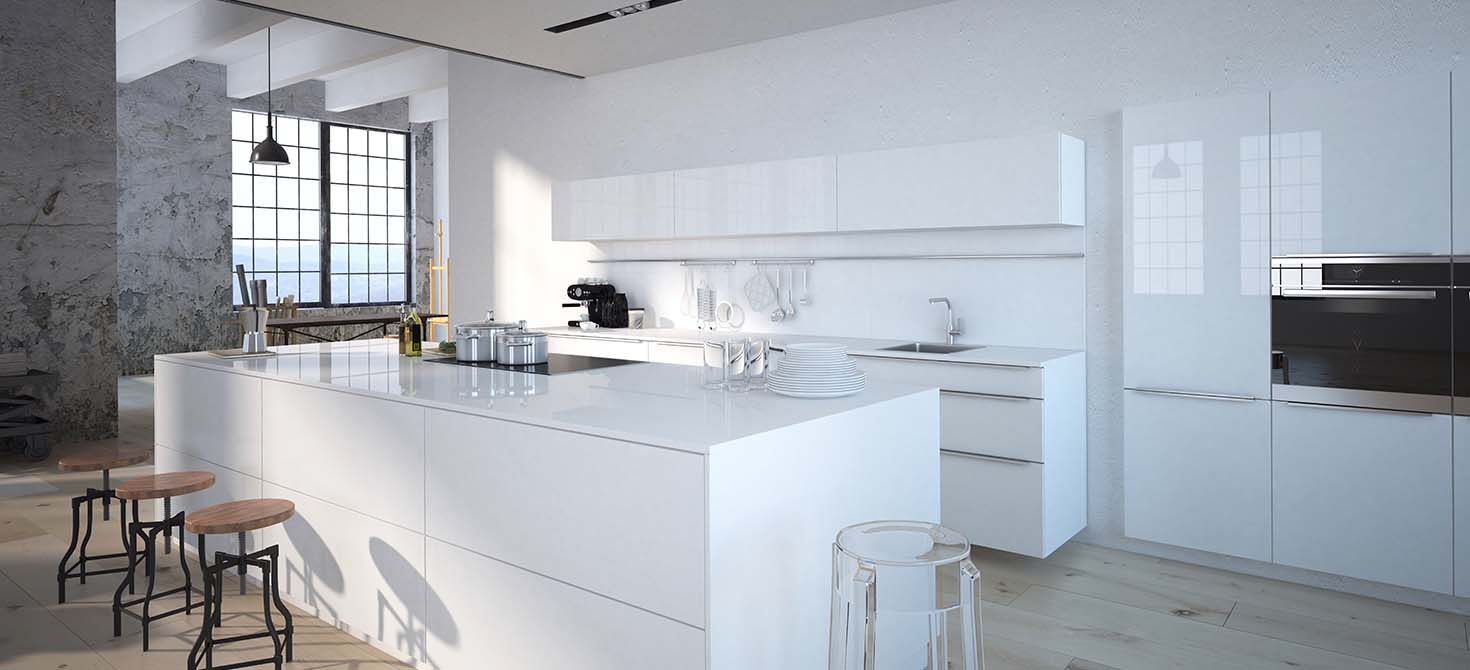- Furnishing trends
- 0 likes
- 2006 views

Suspended kitchens are the latest trend in interior design. But what are suspended kitchens and what are the characteristics and special features of these furnishings? Here is everything you need to know about free-standing kitchens, with particular reference to their advantages, brands and prices.
Index
Modern kitchens with wall-hung base units: features and characteristics
Suspended kitchens have become increasingly popular in recent years and are now a very fashionable and trendy furnishing solution. One of the main reasons for the great commercial success of these kitchens is their ability to give spaces great lightness and modernity, especially in the context of furnishing an open space kitchen-living area.
A suspended kitchen is a piece of furniture characterised by a number of base units or columns - or all of them - that do not touch the surface of the floor and are positioned at an average height of 50 or 70 cm. These kitchens are totally customisable and can be adapted to practically any kitchen.
For the installation of a modern suspended kitchen, special L-shaped support profiles are used, usually made of steel. For the assembly of these structures it is therefore necessary to be well aware of the positions of the existing pipes and the solidity of the supporting masonry. For these reasons, these kitchens are usually installed during the construction or renovation of a building, as it is easier to design them at this stage. If the wall on which the kitchen is to be installed is not load-bearing, it will be necessary to use additional feet - not visible at first glance - to further support the weight of the structure.
Suspended kitchens with a contemporary and innovative design
For young and dynamic environments, there are many models of suspended kitchens on the market today that express a contemporary design, accentuating even more the sense of lightness and airiness that these furnishings are able to guarantee. If we are used to the vision of classic floor-standing kitchens, the first approach with suspended kitchens will be even more evocative and intriguing.
Today's young customers are increasingly interested in design kitchens, conceived to amaze and to be original: suspended kitchens represent in this sense a furnishing solution designed under the banner of innovation and refinement. It is also worth emphasising how suspended kitchens - if carefully lit - are capable of creating truly unique design compositions with great visual impact. For this reason it is very common today to come across suspended kitchens even in bed & breakfasts and holiday homes.

Advantages and disadvantages of a wall-hung kitchen
As far as the advantages of a wall-hung kitchen are concerned, this type of furniture is for everyone, precisely because it has great versatility and the ability to adapt to the most diverse furnishing styles. Those who love practicality and classic style will naturally be more inclined to choose a traditional kitchen, while those who are particularly attentive to style and design and are looking for an environment without too many clutter and objects to store, suspended kitchens could be the ideal furnishing solution.
Suspended kitchens are an exercise in minimalist style, aimed at completely overturning the concept of the classic kitchen, focusing instead on essentiality. In fact, a kitchen that does not touch the ground is not intended to look like a real kitchen but a hybrid and innovative furnishing solution. In addition to stylistic refinement, the advantages of a suspended kitchen also include hygiene: cleaning under the base units is very easy and there is no accumulation of dust. With this furnishing solution the underfloor heating can also work to its full potential, since the kitchen has no bases occupying the floor.
Let us now come to the disadvantages of a wall-hung kitchen: first of all, if we intend to purchase this type of furniture we must consider the greater complexity we will encounter in the assembly phases. In a wall-hung kitchen it is in fact necessary to study everything very carefully, leaving nothing to chance. For this reason, for the design and installation phase, our advice is to rely on professionals or specialised companies.
Above all, the fastening phase must be very careful and precise, since the weight of the structure must be supported adequately and safely. In a kitchen of this type, the appliances will also have to be suspended, and therefore characterised by a lower height than the standard one. Another disadvantage can be represented by the prices of wall-hung kitchens: some models are in fact characterised by higher than average costs. This does not apply to all brands specialising in the production of wall-hung kitchens, although this is very often the case.
Finally, a further disadvantage that characterises these kitchens is the reduction of storage space: since the height of the base units decreases, it will be necessary to compensate with the presence of more columns or more storage space. To overcome this problem it is possible to wisely mix wall-hung base units and floor-standing tall units, or alternatively not to provide all the base units separately, but only some of them.
The main brands specialising in the production of wall-hung kitchens
Below is a list of the main brands specialising in the production and sale of wall-hung kitchens:
- Linear;
- Forma 2000;
- Elmar;
- Ciao Cucine;
- Lyons Kitchens;
- Miton;
- Meson's Kitchens;
- Moretti Kitchens.
